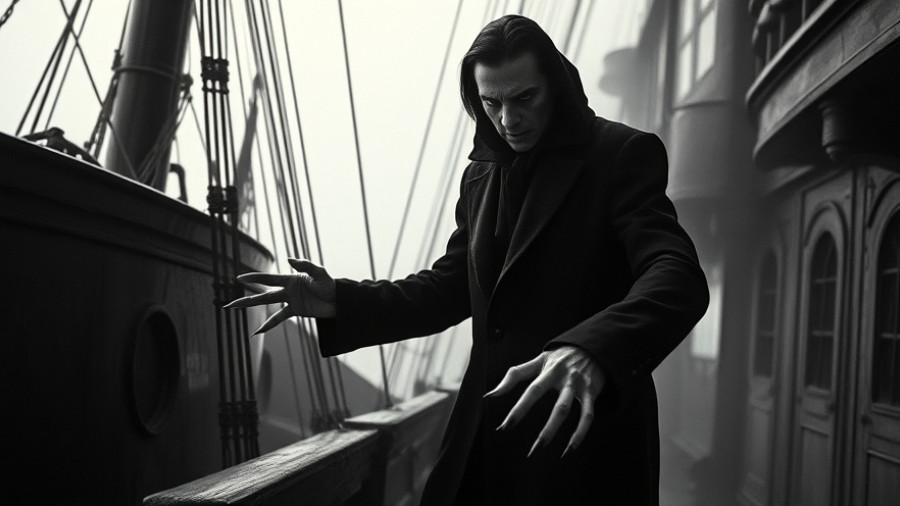
A Journey into Horror: Count Orlok's Legacy
This year marks the 103rd anniversary of Nosferatu, the iconic silent film that introduced audiences to the terrifying Count Orlok, masterfully portrayed by Max Schreck. Orlok’s disfigured visage, complete with protruding fangs, elongated fingers, and an unsettlingly pale complexion, is arguably one of the most chilling figures in cinematic history. Its impact on the horror genre cannot be overstated, serving as a benchmark from which many subsequent horror villains have drawn inspiration.
From the Shadows: The First True Horror Film
Nosferatu was more than just a film; it was a work of art that encapsulated the cultural anxieties of post-World War I Germany. Directed by F.W. Murnau, its expressionist style melded stark lighting, expansive shadows, and unnerving angles to craft an atmosphere thick with dread.
The movie’s masterful cinematography amplified the visceral horror of Orlok by leaning into the use of shadows, a hallmark of German Expressionism. Count Orlok’s climactic scenes—sprawling through the shadows of the staircase, striking fear into the audience without a single jump scare—left a lasting mark on filmmaking techniques.
Sustaining Fear Through Silence
What’s astonishing about Nosferatu is its ability to terrify audiences without relying on modern jump scares or excessive gore. Instead, it amplifies tension through its eerie silence, allowing the dread to seep into the viewers’ minds. Orlok’s presence alone—his unforgettable silhouette—creates an echoing sense of horror that reverberates through time and continues to engage a new generation of viewers even today.
Orlok's Influence: The Blueprint of Modern Horror Monsters
Count Orlok's haunting visage has influenced an entire lineage of horror icons. Take, for example, the monstrous Barlow from Stephen King's Salem's Lot, who bears striking similarities to Orlok with his menacing bald head and claw-like fingers. Similarly, the vampiric archetypes established with Orlok radiate through the genre, seen in creatures from modern series like What We Do in the Shadows to classic adaptations of Dracula.
The template Orlok set laid the groundwork for the visual aesthetics of horror monsters, introducing concepts like the vulnerability of daylight exposure that have now become staples in vampire mythology. The idea that sunlight could kill a vampire originates with Nosferatu, even predating Bram Stoker's own Dracula in establishing possibly lethal traits for its bloodsucking villains.
Counterarguments: Modern Monsters and Their Shadows
While many modern horror villains, such as Pennywise and the Xenomorph from Alien, shine in their supernatural horror, none have captured the essence of fright quite like Count Orlok. These characters, while terrifying, often present as more human or relatable. They hide behind masks of relatability, unlike Orlok, who weathered the unabashed display of horror that stems from his intrinsic monstrosity.
Today’s horror relies heavily on practicality in creating relatable antagonists, but some might argue that the fear of the truly alien—an embodiment of evil devoid of redeeming features—is a resonance that is becoming increasingly rare. In a world saturated with complex villain backstories, Orlok simplifies horror to its most primal form
Narratives Through Generations: The Revival of Nosferatu
The legacy of Nosferatu continues flourishing, especially as filmmakers draw upon its rich narrative and stylistic influences. The upcoming remake from Robert Eggers featuring Bill Skarsgård promises to revisit this haunting tale, presenting Count Orlok for a new era while adhering to the core themes that made him unforgettable. This is a sign that the allure of classical horror, driven by existential dread and unease, remains relevant in today’s cinematic landscape.
Conclusion: Orlok's Enduring Legacy
As we move forward, the essence of Count Orlok serves as a chilling reminder of the capabilities of horror to evoke genuine fear. The haunting figure of Nosferatu elevates not only our understanding of cinematic horror but also echoes the fears harbored within society. Celebrating Orlok is vital as we face new challenges—a reflection on what terrifies us and how those fears may evolve yet again in future narratives.
So, if you haven't yet, I encourage you to watch Nosferatu and immerse yourself in the atmospheric dread and visual terror of this century-old masterpiece. Let Orlok's presence remind us of how fear can transcend time and engagement, creating a powerful bridge between generations.
 Add Row
Add Row  Add
Add 




Write A Comment